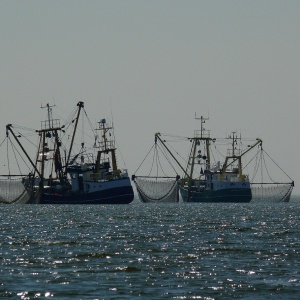
This research shows that global replacement of fish meal and fish oil in aquaculture feed with alternative feeds (including algae, bacteria, yeast and insects) could reduce aquaculture’s demand for forage fish while - depending on the specific mix of alternative feeds - maintaining feed efficiency and levels of omega 3 fatty acids in the farmed fish.
The figure below shows that optimum global use of alternative aquaculture feed ingredients could reduce aquaculture’s demand for forage fish to between 8 and 10 million tonnes in 2030. The three scenarios from left to right are BAU (Business As Usual, based on FAO projections; where global aquaculture production grows by 37% between 2015 and 2030), Rap.Gr. (based on World Bank projections; aquaculture production grows 56% between 2015 and 2030) and Cons.Shft (based on changes in consumer preference in China; aquaculture production grows by 98% between 2015 and 2030). The figure shows that average feed use of forage fish between 1980 and 2013 was around 21 million tonnes per year, while average supply of forage fish was around 30 million tonnes. “Proposed EBFM supply”, around 24 million tonnes per year, is the level of catch proposed under ecosystem-based fisheries management.

Image: Figure 4a of Cottrell et al. Simulated global forage fish savings across animal groups with the incorporation of novel feed ingredients under different aquaculture growth scenarios to 2030.
Abstract
With the global supply of forage fish at a plateau, fed aquaculture must continue to reduce dependence on fishmeal and oil in feeds to ensure sustainable sector growth. The use of novel aquaculture feed ingredients is growing, but their contributions to scalable and sustainable aquafeed solutions are unclear. Here, we show that global adoption of novel aquafeeds could substantially reduce aquaculture’s forage fish demand by 2030, maintaining feed efficiencies and omega-3 fatty acid profiles. We combine production data, scenario modelling and a decade of experimental data on forage fish replacement using microalgae, macroalgae, bacteria, yeast and insects to illustrate how reducing future fish oil demand, particularly in high-value species such as salmonids, will be key for the sustainability of fed aquaculture. However, considerable uncertainties remain surrounding novel feed efficacy across different life-cycle stages and taxa, and various social, environmental, economic and regulatory challenges will dictate their widespread use. Yet, we demonstrate how even limited adoption of novel feeds could aid sustainable aquaculture growth, which will become increasingly important for food security.
Reference
Cottrell, R.S., Blanchard, J.L., Halpern, B.S., Metian, M. and Froehlich, H.E., 2020. Global adoption of novel aquaculture feeds could substantially reduce forage fish demand by 2030. Nature Food, 1(5), pp.301-308.
Read the full paper here. See also the Foodsource resource How do food systems affect fish stocks and marine habitats?







Post a new comment »